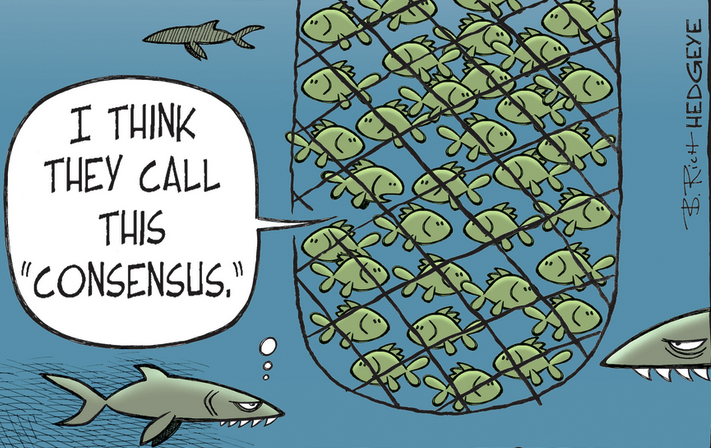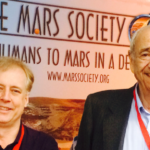Cite as: Benner, S. A. (2021) “Culture, Consensus, and Why NASA Committees Write Things That Are Not True”. Primordial Scoop, 2021, e1102. https://doi.org/10.52400/GKNZ9932
Culture is what we think, when we are not thinking. Every minute, we take many thought-driven actions. We do not have time to build an Aristotelian rationale for each. Therefore, most of our actions are governed by cultural paradigms. Paradigms that we got from our parents, schools, reading, social interactions and, today, the internet.
Even in science, we do not actually know much of what we think we “know”. For example, we are likely to be absolutely certain of the truth of the proposition: “Water is H2O”. But I wager that most of us do not know how we “know” that water is H2O.
This question can be separated into two questions. A historical question asks how civilization came to know that water is H2O. In philosophy, this is called the “context of discovery”. For water, the fascinating answer is rooted in early 19th century observations that were made when burning organic molecules and weighing the amount of water and CO2 evolved. The story includes names like Loschmidt, Avogadro, and Ampère.
A separate question ignores history, instead asking for the best reason today to assert the validity of a proposition. Today, I might cite analyses of ice crystals by x-ray diffraction, not developed until long after water was known to be H2O. This (and now many other) observations do not “prove” that water is H2O. But they show that if water is not H2O, many other propositions that we think are true must be abandoned. Actually, many, many (many) others.
So culture is necessary to manage daily life, but it has its down side. Indeed, philosophers and historians of science love to point out how culture obstructs scientists as they try to do science, in part by institutionalizing “knowledge” that is wrong. They explore this by reading what actual scientists actually write when they are seeking to persuade professionally. They follow mistakes as they enter textbooks.
And white papers.
A White Paper [1] published last week from a Workshop commissioned by NASA provides a good teaching framework for this exploration. The White Paper asserts as true many propositions that are, in fact, not true. Thus, as a cultural document, it will let historians and philosophers write essays for years about how culture obstructs the ability of NASA scientists to do science.
Let us take just one paragraph, 213 words long, from the White Paper (p. 6), quoted word for word from its 28 October draft. with citations omitted:
“One of the most famous claims for extant microbial life on Mars is from the Labeled Release (LR) experiments carried out by the NASA Viking Landers in the 1970s. The LR experiment tested for the presence of a metabolism in Mars regolith by injecting organics containing radioactive carbon-14 as a marker into a sample holder containing collected regolith and observing whether organics were consumed or transformed. While change was initially observed, a second gas injection produced no further labelled gas production and no organics were detected by Viking’s Gas Chromatograph-Mass Spectrometer (GCMS) in the Martian soil or atmosphere. However, an abiotic origin for the LR result is supported by results from both Viking’s Gas Exchange (GeX) experiment and later discoveries by NASA’s Phoenix and Mars Science Laboratory of the presence of oxychlorine compounds (Ca0 and Mg-perchlorates and chlorates) on the Martian surface. These compounds were found to react during the heating process of analysis, leading to oxidation and chlorination reactions that destroyed the organic molecules under investigation. A biosignature detection framework applied to the LR result at the time of discovery could have more clearly indicated that while extant biology could be responsible for the gas evolution, an abiotic interpretation had not yet been ruled out, reducing confidence in the potential biosignature detected.”
First, let us correct the bad prose and transparent mistakes in these 213 words. The release of radioactivity from the soil was observed, not “whether organics were consumed or transformed”, or “changed”. There was no “heating process” in any of the experiments, except the GCMS (and this is important). “Ca0” is not an “oxychlorine compound”.
We might then object to the lack of Aristotelian parse-ability of the argument. The committee evidently lacked someone who stood up to ask during the drafting: “What exactly is the point supposed to be in this paragraph?”
But reading a bit into the prose, we gather that the paragraph is intended to persuade us readers that we should endorse the Workshop’s effort to construct a “biosignature detection framework” (BDF) to guide future NASA missions.
And what logic is offered to persuade? Evidently, the authors want us to agree that if only the BDF developed in the Workshop had been available to Gil Levin and Patricia Straat “at the time of discovery” in 1976, they would have known that an “abiotic interpretation had not yet been ruled out” for the label release results.
The committee needed someone to have stood up at that point to say (in the vernacular) “Bullshit”.
Unfortunately, committees have their own social dynamic. Knowledge, courage, and language skills are required in committee for an individual to oppose a “consensus” train, even if it is headed towards a wreck. Knowledge to explain why the consensus is wrong. Courage to risk the opprobrium of your peers, who may retaliate on your next grant application. Language skills to divert the consensus away from the wreck with linguistic delicacy.
Indeed, it seems that some individuals originally participating in the Workshop were willing to say “bullshit” from time to time. Evidently, the Workshop organizers threw those individuals well … not to the sharks. But the Workshop organizers threw out of the workshop individuals who advocated non-consensus positions too “enthusiastically”. Comparing the final draft with intermediate drafts suggests that the unapproved ideas were also thrown out. More on this in future blog posts.
So what material in this paragraph is wrong? Well, pretty much everything else. Specifically:
• The White Paper says that “no organics were detected by Viking’s Gas Chromatograph-Mass Spectrometer (GCMS) in the Martian soil or atmosphere.”
In fact, the GC-MS detected chloromethane, methylene chloride, benzene, acetone, Freon-E, and methylfluorosiloxane. Some of these were attributed to cleaning solvents and detected in the flight to Mars, making them terran organics. Later, the Phoenix lander found perchlorate in Martian soil at another location. If perchlorate were at the Viking sites, it would have burned any organics that were there to CO2 and H2O at 500 °C, with small amounts of chloromethane and methylene chloride produced as by-products. The expected CO2 was also observed. Some relevant back and forth can be found in references 2-9.
In short, the GCMS experiments cannot be used to rule out the presence of organics “in the Martian soil or atmosphere”. The White Paper is wrong.
• The White Paper says that “an abiotic origin for the LR result is supported by results from … Viking’s Gas Exchange (GeX) experiment.”
Wrong again. The GeX experiment showed the evolution of O2, CO2, and some other species (Table 4 of Ref. [2]) at low temperatures. This result has no particular relevance to the interpretation of the LR results, and certainly does not suggest an “abiotic origin”. Here, a large literature is summarized by references [3]-[10].
• The White Paper says that “an abiotic origin for the LR result is supported by … later discoveries by NASA’s Phoenix and Mars Science Laboratory of the presence of oxychlorine compounds on the Martian surface. These compounds were found to react during the heating process of analysis, leading to oxidation and chlorination reactions that destroyed the organic molecules under investigation.”
Wrong again. The Phoenix lander did find perchlorate; perchlorate is indeed an “oxychlorine compound”. And yes, at 500 °C, perchlorate destroys organics (vide supra). Indeed, that is the core reason why any failure of the GCMS to find organics makes no statement about the absence of organics at the Viking site.
But perchlorate is entirely harmless to organics at the low temperatures where the LR experiments were done.
Therefore the presence of “oxychlorine compounds” did not support, and could not have supported “an abiotic origin for the LR results”. The label was released at temperatures well below temperature at which “oxychlorine compounds” would have released label. The White Paper is wrong again.
Aristotelian logic is a wonderful thing. All of the material premises of the 213 words leading to the argued conclusion are incorrect. Hence, the conclusion remains unargued. These 213 words do not suggest that we need a NASA committee to deliver to us a “biosignature detection framework”.
So what are we to do with these 213 words?
One might offer an ad hominem conclusion. That is, one might agree that we need a “biosignature detection framework”, but just not one constructed by these particular people.
I think that this conclusion would be wrong.
First, I know many of the people who worked many hours to contribute to this White Paper. I trust the scientific judgement of each of them … individually.
Further, each of the mistaken premises is actually institutionalized in the culture. If you have not actually read the papers of Levin, Straat, Biemann, Horowitz, Navarro-González, McKay, Quinn et al. and (of course) Benner and Devine [10], you would not know that this “consensus wisdom” is wrong.
Rather, I think that the take-home lesson concerns NASA’s administrative culture. It is as if NASA believes that a Platonic Philosopher King can take the form of the utopian consensus committee. NASA’s administrative culture actually seems to believe that the rough and tumble anarchy that characterizes post-Enlightenment science can be productively replaced by concensus-by-committee, from which we proceed.
Of course, research funds, mission priorities, and flight payloads are also determined by committees, both at NASA and elsewhere. Later, the White Paper, productively discusses some of the ways that committees and censuses hinder here.
But that is a topic for a later post.
[1] Unauthored (2021) “Biosignature Standards of Evidence Whitepaper”, Network for Ocean Worlds.
[2] Klein, H. P., Horowitz, N. H., Levin, G. V., Oyama, V. I., Lederberg, J., Rich, A., … & Johnson, R. D. (1976). The Viking biological investigation: preliminary results. Science, 194(4260), 99-105.
[3] Biemann, K., Oro, J. I. I. I. P. T., Toulmin III, P., Orgel, L. E., Nier, A. O., Anderson, D. M., … & Lafleur, A. L. (1977). The search for organic substances and inorganic volatile compounds in the surface of Mars. Journal of Geophysical Research, 82(28), 4641-4658.
[4] Biemann, K. (1979). The implications and limitations of the findings of the Viking organic analysis experiment. Journal of Molecular Evolution, 14(1-3), 65-70.
[5] Navarro‐González, R., Vargas, E., de La Rosa, J., Raga, A. C., & McKay, C. P. (2010). Reanalysis of the Viking results suggests perchlorate and organics at midlatitudes on Mars. Journal of Geophysical Research: Planets, 115(E12).
[6] Navarro‐González, R., Vargas, E., de la Rosa, J., Raga, A. C., & McKay, C. P. (2011). Correction to “Reanalysis of the Viking results suggests perchlorate and organics at midlatitudes on Mars”. Journal of Geophysical Research: Planets, 116(E8).
[7] Biemann, K., & Bada, J. L. (2011). Comment on “Reanalysis of the Viking results suggests perchlorate and organics at midlatitudes on Mars” by Rafael Navarro‐González et al. Journal of Geophysical Research: Planets, 116(E12).
[8] Navarro‐González, R., & McKay, C. P. (2011). Reply to comment by Biemann and Bada on “Reanalysis of the Viking results suggests perchlorate and organics at midlatitudes on Mars”. Journal of Geophysical Research: Planets, 116(E12).
[9] Quinn, R. C., Ehrenfreund, P., Grunthaner, F. J., Taylor, C. L., & Zent, A. P. (2007). Decomposition of aqueous organic compounds in the Atacama Desert and in Martian soils. Journal of Geophysical Research: Biogeosciences, 112(G4).
[10] Benner, S. A., Devine, K. G., Matveeva, L. N., & Powell, D. H. (2000). The missing organic molecules on Mars. Proceedings of the National Academy of Sciences, 97(6), 2425-2430.




Hi Steve, great article which exposes the true nature of the consensus culture at NASA! I’d like to point out that the Viking LR experimental controls, in which the samples + 14C-labeled nutrients were heated to 50°C, 100°C and 150°C and were all negative, completely refutes the conclusion that oxychlorines were responsible, as perchlorates remain stable until the temperatures exceed 300°C. I would conclude from this that a biological explanation for the LR results is still the most likely, as NO exact abiotic chemical replication of them has been achieved to date.
Please put me on your mailing list.
Benner does us a service in reviewing the many falsehoods cited in the NASA white paper. It is disturbing that its authors would illustrate the putative usefulness of a “universal” biosignature detection framework in this manner, especially since, as Benner points out, the authors should have been aware that these examples were being (at best) misrepresented.
As a philosopher, however, I can’t help but wonder why Benner feels it necessary to base the problems that he attributes to NASA’s administrative “culture” on a personal general theory of culture. The term “culture” is used very loosely in the English language to encompass a variety of aspects of human life, including arts, customs, social institutions, and other manifestations of intellectual achievement; indeed, a recent research paper speaks of “elephant culture,” underscoring the vagueness of the term.
In any case, the NASA “culture” responsible for the white paper lacks many of the characteristics classically attributed to culture. Because it is based on so many errors the white paper hardly counts as, for instance, a “manifestation of intellectual achievement”.
Instead of trying to reason from “culture” considered in a general, very vague sense, Benner would be better off beginning with a discussion of specific characteristics of NASA’s administrative “culture” that make it prone to unselfconsciously promulgating misinformation. This strikes me as an interesting issue.
I worked on the Viking Lander missions (true, on the test of Relativity, not the biology, but I did get to observe things) and have simply never understood why Horowitz and the others came to the consensus that that the Gas Chromatograph-Mass Spectrometer (GCMS) simply trumped the mixed biological experiments (one was positive, one was negative, and one was hard to interpret), and therefore life on Mars was impossible. It seemed unwise, unscientific and directly led to the firing of almost an entire generation of Mars science researchers and decades in which it was very hard for anyone to work on current Mars biology.